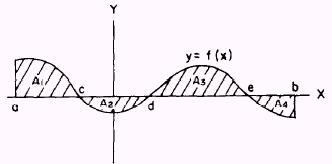|
SOLUTION: Substituting into equation (6.7), we have

The area above a curve and below the X axis, as shown in
figure 6-11, will, through integration, furnish a negatvie answer.

Figure 6-11.-Area above a curve.
If the graph of y = f(x), between x = a and x = b, has
portions above and portions below the X axis, as shown in figure 6-12, then

is the sum of the absolute values of the positive areas
above the X axis and the negative areas below the X axis, such that

where


Figure 6-12.-Areas above and below a curve.
EXAMPLE: Find the areas between the curve
y=x
and the X axis bounded by the lines
x= -2
and
x=2
as shown in figure 6-13.

Figure 6-13.-Negative and positive value areas.
SOLUTION. These areas must therefore, we write be computed
separately;

and the absolute value of - 2 is

Then,

Adding the two areas,
 , we find
, we find

NOTE: If the function is integrated from - 2 to 2, the
following INCORRECT result will occur:

This is obviously not the area shown in figure 6-13. Such
an example emphasizes the value of making a commonsense check on every solution. A sketch of
the function will aid this commonsense judgement.
EXAMPLE: Find the total area bounded by the curve

the
X axis, and the lines
x=
-2
and
x=4
as
shown in figure 6-14.
SOLUTION. The area desired is both above and below the X axis;
therefore, we need to find the areas separately and then add them together
using their absolute values.

Figure 6-14.-Positive and negative value areas.
Therefore,

and

Then, the total area is

|

